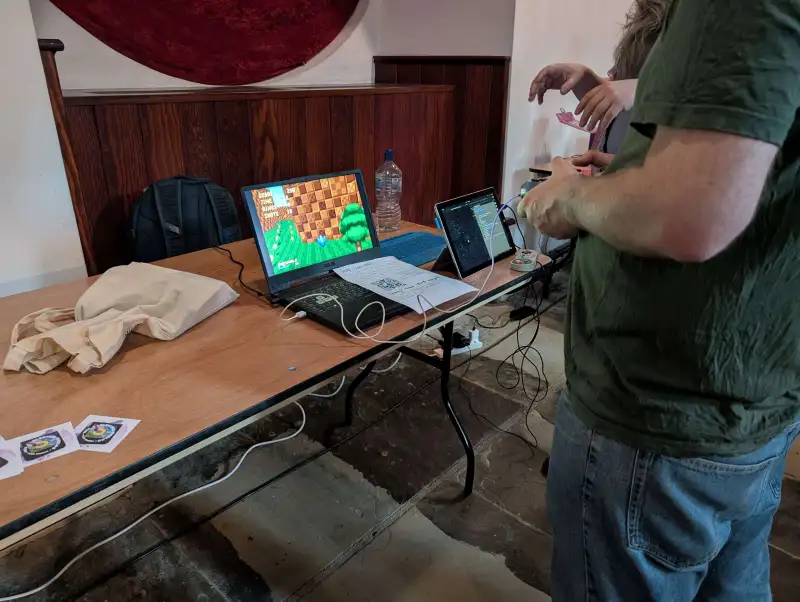
My first expo
I exhibited at a showcase for local game makers yesterday. It was the first time I had done something like that and it was extremely fun and utterly exhausting. Working on games is an occasionally hobby; I don’t intend to make it my job and I haven’t worked on any game projects since the game jam last year, but I dusted off Snolf Robo Blast 2 and Conway’s Garden and set them up with some controllers for people to try out.

I had not thought about how exhibiting these would work before the event but I quickly realised that I was going to have to give a lot of context to people as to what they were playing. The vast majority of people attending never heard of Sonic Robo Blast 2 before so I had to give a quick rundown to everyone on what it was and sometimes the concept of fangames and mods.
Even with that explained, though, it became apparent how awkward it was to try to convey what the mod is doing when people seeing it do not have a context of the base game and how the mod is creating an experience on top of that. They are coming in and seeing and playing this game for the first time and expecting it to be a coherent whole, not this deliberate awkward layer on top of a base game. You don’t have the context that the joy in it is that you are playing the game “wrong”, layering a control scheme and method of play that the world was not intended for. Many people when seeing it as a golf-type thing started looking for a hole or guidance on where they are shooting for. The levels have a fairly legible linear structure when played normally, but when you have never seen them before and can freely shoot yourself much farther and higher than the levels for designed for, bouncing every which way, it is become very difficult to parse the structure of the space. More than one person suggested there should be guiding arrows of some sort to help.
Some people, though, did gel with it straight away and were delighted by blasting Snolf around, which was really nice to see. I was quick to give credit to the SRB2 team for the game itself and Dr. Melon for the concept. A line I fell into saying that got a laugh from a lot of people is that “all I did was make the controls worse.” A lot of people also got a kick out of it when I pointed out that the game was technically an extremely heavily modified version of Doom. Some people did have more of a concept of an antigame and compared it to QWOP and Getting Over It when I tried to explain the awkwardness of it not being entirely unintentional and the other game makers there generally got it and found it interesting. There were a few parents who brought children, including a Sonic fan or two, and they gravitated over to it being one of the more brightly coloured, exciting looking things on display, only to get pretty frustrated with it. For the kids at least I did quickly quit back to the main menu and restart the game with normal Sonic so that they could have a bit of fun trying it out and gave on the details of SRB2 to their parents if they were interested in it, pointing out that it was free. I think if exhibiting it again it would be useful to have a second computer set up with the unmodified version of the game, both to give context and to allow any child who sees Sonic and gets excited to play something that would actually be fun for them.
Similarly for Conway’s Garden I had to let people know that there wasn’t really any goal or point to it and it was more of a piece of art and a challenge to make something in a tiny amount of code. I had the code open in a second in a second window to the side so people could see how small it was for themselves. A lot of people, quite fairly, lost interest in it quickly, but some people were fascinated by the highly condensed code and the idea of tweetcarts and Pico-8 itself and a surprising number of people were already familiar with and recognised Conway’s Game of Life.
There was one man in particular I had a lovely chat with who was unfamiliar with games generally (he had to ask to clarify if “mods” was short for “modifications”) but enthusiastic about discussing the things on display as art. He said the mix of chaotic generation with the player’s simple, deliberate movements in Conway’s Garden reminded him of Joseph Beuys’s I Like America and America Likes Me and immediately recognised the Sisyphean nature of Snolf.
I don’t know if I will do anything like this again any time soon (and I won’t be working on anything new to show for the moment) but I had a great time and met some very cool people.

